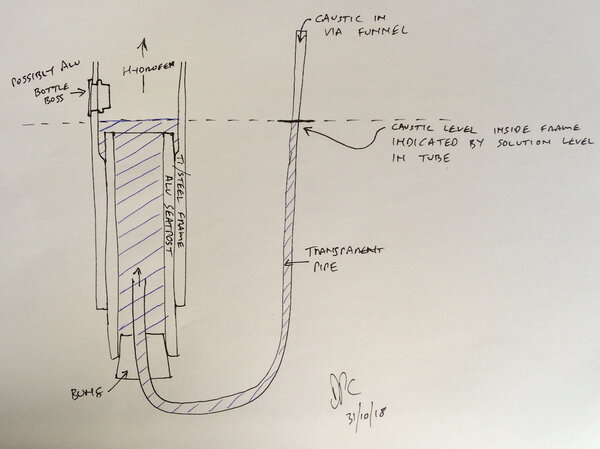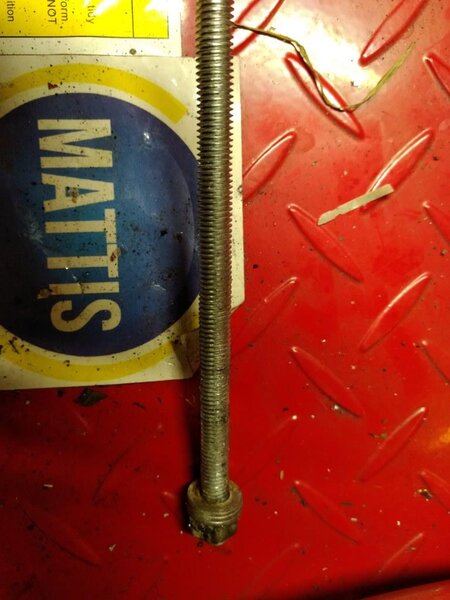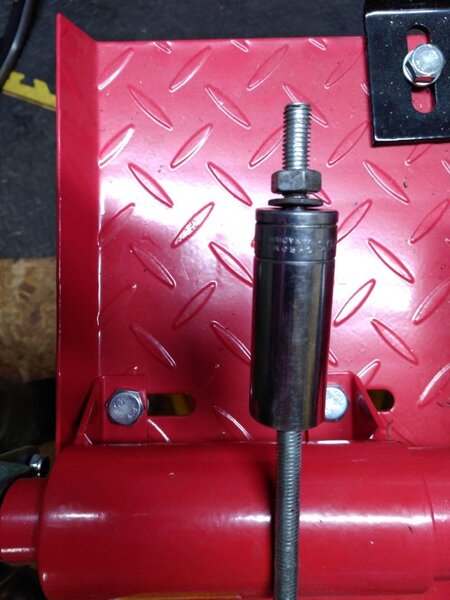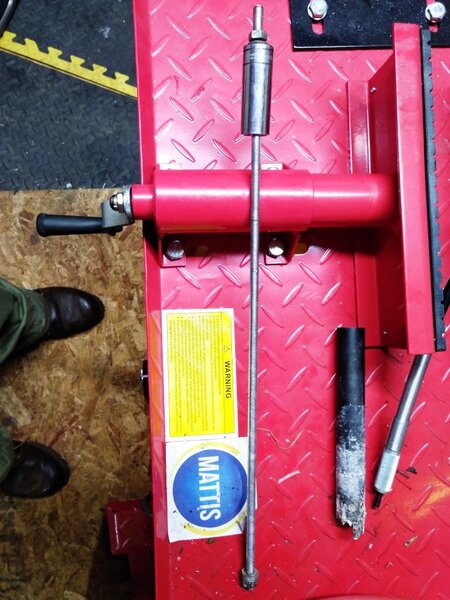You are using an out of date browser. It may not display this or other websites correctly.
You should upgrade or use an alternative browser.
You should upgrade or use an alternative browser.
caustic soda on a seat post
- Thread starter 1duck
- Start date
Ok - so I've had a long chat with John (the seatpostman) on Sunday. He'd already looked at my pics. He's a very decent chap, and was very helpful, but, the long and short of it, was that he has gone straight to caustic as the solution to remove the seatpost remnant! However, this is with a couple of proviso's that we're still looking at:
1 - His method of removal is purely tooling, and he agreed with me that the massive butt that's about 60mm into the top of my seat-tube, will make using his method extremely difficult and extremely expensive. He sort of implied that it just wouldn't work to be honest with you.
2 - It now makes sense why the expanding foam was squirted in. The utter tool that pushed the remnant of the post into the tube in the first place, had clearly had it stuck in the 60mm of "butted" 27.2mm section of the tube. Once the seatpin had been cut and knocked in, the main part of the seat-tube is way bigger (thinner) than the butted section, and it would have rattled around loose like a bitch - clearly this was simply to stop it rattling around. In itself, this is fairly useful, as once the foam has been dissolved (he thought I might be able to use ammonia to do this?), the remnant should likely be very loose in the tube, and should move around like a small tube, within a tube.
3 - He agreed with me that the bottom bracket shell probably does have a piece of pressed-in collar, which could well be an alloy that won't take kindly to the caustic. He recommended trying to get this pressed out, to make it nicer to get the caustic into the seat-tube in any case.
4 - It's looking more likely that the bottle bosses are ally. If I can get the bottom bracket collar pressed out, and feed a pipe into the seat-tube (with the frame inverted) and the seat-tube opening plugged and covered, and don't take the level of the tube above that, or particularly close to the upper bottle boss, they might live through it without too much damage! He did comment that these could be replaced if need be, but I'd still like to avoid that if I can!
5 - He was very confident that the 60mm seat-tube butted section was just pure Ti. He thought that the three holes that feed into two stays and the top tube, were a giveaway that there wasn't any sort of pressed in ally collar, as if there had been, you'd see a the "top hat" lip of the collar, sitting on the top of the seat-tube, and there is none on this frame.
Therefore, the best solution I've got at the moment, is to:
1 - Dissolve the remnants of the expanding foam with ammonia
2 - Eat that sucker out with a caustic concoction in an inverted frame, with the bottom bracket collar pressed out for access into the tube through the bottom bracket (and to stop the collar itself from being damaged by this process).
Any thoughts as I continue to mull this over?
1 - His method of removal is purely tooling, and he agreed with me that the massive butt that's about 60mm into the top of my seat-tube, will make using his method extremely difficult and extremely expensive. He sort of implied that it just wouldn't work to be honest with you.
2 - It now makes sense why the expanding foam was squirted in. The utter tool that pushed the remnant of the post into the tube in the first place, had clearly had it stuck in the 60mm of "butted" 27.2mm section of the tube. Once the seatpin had been cut and knocked in, the main part of the seat-tube is way bigger (thinner) than the butted section, and it would have rattled around loose like a bitch - clearly this was simply to stop it rattling around. In itself, this is fairly useful, as once the foam has been dissolved (he thought I might be able to use ammonia to do this?), the remnant should likely be very loose in the tube, and should move around like a small tube, within a tube.
3 - He agreed with me that the bottom bracket shell probably does have a piece of pressed-in collar, which could well be an alloy that won't take kindly to the caustic. He recommended trying to get this pressed out, to make it nicer to get the caustic into the seat-tube in any case.
4 - It's looking more likely that the bottle bosses are ally. If I can get the bottom bracket collar pressed out, and feed a pipe into the seat-tube (with the frame inverted) and the seat-tube opening plugged and covered, and don't take the level of the tube above that, or particularly close to the upper bottle boss, they might live through it without too much damage! He did comment that these could be replaced if need be, but I'd still like to avoid that if I can!
5 - He was very confident that the 60mm seat-tube butted section was just pure Ti. He thought that the three holes that feed into two stays and the top tube, were a giveaway that there wasn't any sort of pressed in ally collar, as if there had been, you'd see a the "top hat" lip of the collar, sitting on the top of the seat-tube, and there is none on this frame.
Therefore, the best solution I've got at the moment, is to:
1 - Dissolve the remnants of the expanding foam with ammonia
2 - Eat that sucker out with a caustic concoction in an inverted frame, with the bottom bracket collar pressed out for access into the tube through the bottom bracket (and to stop the collar itself from being damaged by this process).
Any thoughts as I continue to mull this over?
The foam solvent is more likely to be acetone, rather than ammonia.
I have used an acetone-based degreaser for this: Interflon Metal Clean, but it's pricey unless you just happen to have some around.
It's always easier to clean off before a full cure (so too late there).
However, there are several commercially available solvents claiming to be specifically for cured PU foam such as No Nonsense Gun Cleaner, and Everbuild Foam Eater...and, at under a fiver, worth giving a go.
All the best,
I have used an acetone-based degreaser for this: Interflon Metal Clean, but it's pricey unless you just happen to have some around.
It's always easier to clean off before a full cure (so too late there).
However, there are several commercially available solvents claiming to be specifically for cured PU foam such as No Nonsense Gun Cleaner, and Everbuild Foam Eater...and, at under a fiver, worth giving a go.
All the best,
Also..other thoughts on the caustic feed...
To save having to disturb the alu sleeve in the BB shell, how about making a u-bend feed for the caustic?
This way you can accurately set the level of the caustic solution in the seat tube,and easily flush/drain it out to refresh.
As long as there is a route for the hydrogen to vent, it should be relatively clean and safe:
All the best.
To save having to disturb the alu sleeve in the BB shell, how about making a u-bend feed for the caustic?
This way you can accurately set the level of the caustic solution in the seat tube,and easily flush/drain it out to refresh.
As long as there is a route for the hydrogen to vent, it should be relatively clean and safe:
All the best.
Attachments
- Feedback
- View
That’s ace ^
Bit of home brew pipping and away you go
Bit of home brew pipping and away you go
danson67":fay4xnpt said:Also..other thoughts on the caustic feed...
To save having to disturb the alu sleeve in the BB shell, how about making a u-bend feed for the caustic?
This way you can accurately set the level of the caustic solution in the seat tube,and easily flush/drain it out to refresh.
As long as there is a route for the hydrogen to vent, it should be relatively clean and safe:
All the best.
Danson
That's a marvellous post - thank you so much for taking the time and trouble to pop up that suggestion! I like the fact that you've copyright signed it!
The reason for my slow response is because I'd been put in touch with a local framebuilder by Lockes in Deal - which is a usefully old school sort of bike shop. Not too many of those knocking about these days!
I popped into see him to see what ideas he had, and before I'd really agreed to it, he'd booked it in with a "I can sort that out"... okey dokey I said; Knock yourself out!
I got a text from him earlier today informing me that "it's all out".
I don't yet know how this was done, but I did make it clear that forum users would be very interested in what he did, and he promised to take some pics of what he did to remove it.
Sadly, it transpires that both the butt at the top of the seat-tube, and the sleeve within the b/b shell are both aluminium, so I couldn't have used this marvellous U-bend suggestion, as it would have eaten through the seat-tube collar rendering it unable to insert a seatpin! This is why I've been so slow to really make progress with this, as it's been really bloody hard to work out whether these were ally or not!
Once again, many thanks for taking the time and trouble to draw the schematic. It's marvellous...
- Feedback
- View
Re:
All ears
All ears
Apologies for the delay - been quite busy of late...
Ok, the solution was fairly simple as it turns out. I'd already worked out how to the seatpin to the butt of the seat-tube, but it was getting it past the butt that was stumping me.
The framebuilder built a custom slide hammer, using a long'ish steel threaded rod - looks like a low-grade wall tie to me of about M6 / M8 thread - with some washers and a nut on the long end, which were just narrow enough to be fed through the 27.0mm seatpin remnant, and with an old socket and nut on the pulling end.
Some alcohol to dissolve the foam, and the remnant could be lifted up to the bottom of the butt. This is the clever bit that I couldn't think of - he then used some special metal working pliers, that are particularly long to squeeze down on the broken end of the seatpin, in parts breaking it, and in other parts bending it in, to make nicely more narrow than the 27.0mm diameter of the butt.
Once the top of this had been fed and pulled into the opening of the butt at the bottom, some lube and the action of the slide hammer was enough to bring the corroded remnant out through the seat-tube opening, as if you were simply removing a stiff seatpin. It was some effort, but relatively straightforward apparently!
A metal cleaning brush on a flexible hammer extension was then used to poke down the seat-tube and clean out anything that might have been remaining on the inside of the tube.
Overall, a lovely job. No corrosive's used. No damage to the frame. This had even defeated the seatpostman!
Ok, the solution was fairly simple as it turns out. I'd already worked out how to the seatpin to the butt of the seat-tube, but it was getting it past the butt that was stumping me.
The framebuilder built a custom slide hammer, using a long'ish steel threaded rod - looks like a low-grade wall tie to me of about M6 / M8 thread - with some washers and a nut on the long end, which were just narrow enough to be fed through the 27.0mm seatpin remnant, and with an old socket and nut on the pulling end.
Some alcohol to dissolve the foam, and the remnant could be lifted up to the bottom of the butt. This is the clever bit that I couldn't think of - he then used some special metal working pliers, that are particularly long to squeeze down on the broken end of the seatpin, in parts breaking it, and in other parts bending it in, to make nicely more narrow than the 27.0mm diameter of the butt.
Once the top of this had been fed and pulled into the opening of the butt at the bottom, some lube and the action of the slide hammer was enough to bring the corroded remnant out through the seat-tube opening, as if you were simply removing a stiff seatpin. It was some effort, but relatively straightforward apparently!
A metal cleaning brush on a flexible hammer extension was then used to poke down the seat-tube and clean out anything that might have been remaining on the inside of the tube.
Overall, a lovely job. No corrosive's used. No damage to the frame. This had even defeated the seatpostman!
Attachments
Similar threads
- Replies
- 11
- Views
- 639
- Replies
- 12
- Views
- 1K



